Quarter three 2024 - Investment performance report
4th October 2024
-
Gavin Jones See profile
Recent world events have shone a light on the risks of investing. The last few years have seen the uncertainty of a War between Russia and Ukraine and, more recently, the escalation of the situation in the Middle East is rapidly becoming a global concern. These are serious situations and the risks are very real but, in terms of investment, these risks are assessed each day by stock markets and the prices are set accordingly.
There is always risk in investing, which is why you should expect a higher return than putting your money in a ‘safer’ solution. The graph below shows stock market performance over the last 20 years and overlaying major events that had occurred in that time, including previous events in the Middle East. Markets will react to events but, as can be seen, they also recover.
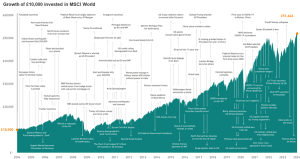
Source: Factset, Past performance is not a guide to future returns, chart(s)/data for illustration purposes only.
As we discussed above, we try and manage these risks by wide diversification of companies in your portfolios and for those who choose to have less exposure to risk we mix in assets that would protect value in the event of a stock market fall.
Performance over the third quarter (from Friday 28 June 2024 to Monday 30 September 2024)
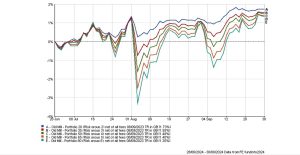
Portfolios ended the quarter higher despite several bumps along the way. Fears of a US recession at the beginning of August caused some sharp falls in global stock markets before resilient economic data calmed nerves.
Performance over the last year (up to Monday 30 September 2024)
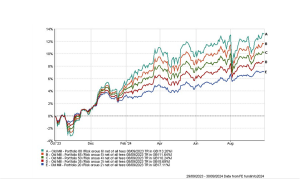
Over the year, all portfolios are higher. As inflation continues to ease there has been growth for most assets – both growth and defensive. For those prepared to take on more investment risk the rewards have been a double-digit increase in the last twelve months. For those more cautious there has also been a good return, ahead of inflation.
Longer term performance over the last 10 years (up to Monday 30 September 2024)
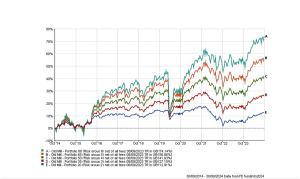
The ten-year returns illustrate the value of investing over the longer term. It also highlights that in pursuing higher returns, there will be periods of volatility that call for patience and trust in the investment process. Nowhere did we see this more than in the early days of the COVID-19 pandemic in spring 2020.
The graph below also shows the performance of portfolios from 2011 to date against similar multi-asset managers where the orange dots show the performance of each portfolio we have.
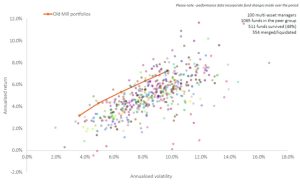
Source: Morningstar direct
Comparing each fund against managers taking a similar risk the results show that our portfolios have surpassed a majority of those managers.
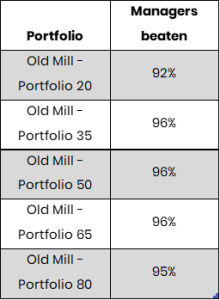
Performance over the first quarter (from Friday 28 June 2024 to Monday 30 September 2024)
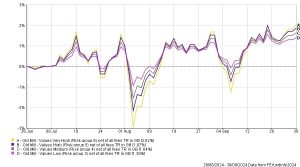
Values portfolios have seen similar returns over the period to standard portfolios.
Performance over the last year (up to Monday 30 September 2024)
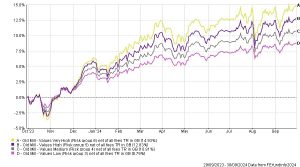
Performance over the last year for values portfolios has been slightly positive when compared to the original portfolios with the ESG screened global equity fund showing strong performance.
Longer term performance over 10 years (up to Friday 28 June 2024)
The values portfolios have only been available to our investors for the last five years, but the graph below shows the longer time frame of ten years showing the potential upside over longer periods.

Longer-term performance of the values portfolios shows robust growth.
The table below shows the performance of a number of asset classes in 2024 so far and the annualised return over year to date (YTD) and 1-year as of close of play on Monday 30 September.
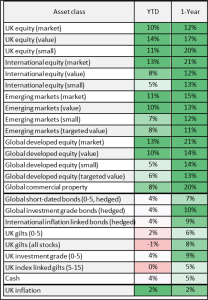
October brings our annual rebalance for portfolios held in ISAs, Pensions and Bonds on the M&G Wealth platform. Taxable accounts are not automatically rebalanced as these have potential tax consequences, so we discuss any actions at our review.
Rebalancing is the practice of realigning the components of a portfolio of investments back to a target allocation from which it has drifted away. Naturally, the process is contrarian and results in selling part of the growth assets that have done well and reinforcing defensive assets that haven’t increased to the same degree.
Left un-rebalanced, a portfolio comprising 60% global equities (‘growth assets’) and 40% short-dated global bonds (‘defensive assets’) would have drifted to nearly 80% in growth assets over the past 10 years. This is a material change in risk exposure.
Figure 1: Drift in growth/defensive asset exposure of 60/40 portfolio from Sept-14 to Aug-24
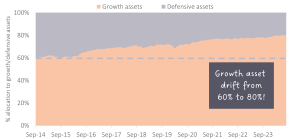
Source: Albion Strategic Consulting. Data source: Morningstar Direct © Growth assets: Vanguard Total World Stock Index Fund Admiral VTWAX, Defensive assets: Vanguard Global Short-Term Bond Index Fund VGSTBGA. Monthly returns in GBP.
The figure above illustrates the primary need for rebalancing, i.e. to prevent unwanted asset allocation drift. You can see that, without rebalancing over this period, the growth assets would have grown from 60% to 80%. Whilst this is positive, the downsides of higher growth assets, if your attitude to risk had not changed, would be a potentially much bigger fall in the value of your portfolio in the event of a stock market fall. Evidence supports that this is the main role of rebalancing*. It is a process which encourages good investor behaviour and helps avoid falling foul of biases. Rebalancing helps our investors maintain a well-diversified solution through time, enabling them to benefit from exposures to imperfectly correlated assets.
‘Investors hoping to profit in the short term from rebalancing trades face certain long-run disappointment. The fundamental purpose of rebalancing lies in controlling risk, not enhancing return.’ – David F. Swensen, Pioneering Portfolio Management (2000)
*E.g. Albion, (October 2023). ‘Governance Update 26: Assessing rebalancing strategies’
Figure 2: The process of rebalancing requires selling what has performed best

Source: Albion Strategic Consulting
In some cases, contributions to and withdrawals from your portfolio can be used to nudge the allocation towards the target to keep risk in line. Keeping a watch on how far your portfolio drifts from its target is something your financial planner will monitor behind the scenes. At times of market turmoil, the issue of a potential rebalance may be considered – in order to realign risk – and don’t be surprised if we raise this with you at such a time.
Please contact your Old Mill financial planner if you would like to discuss the performance of your portfolio.

